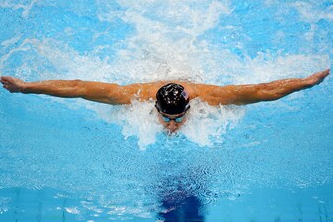Olympic Swimming for Dummies

Image courtesy of Olympic.org
February 8, 2021
Humans have been swimming from the beginning of time, to get across lakes and rivers of course but also to have fun. With the track record of humans, it’s not surprising swimming has become competitive. “Swimming has featured on the programme of all editions of the [Olympic] Games since 1896” (Olympic.org). The postponed summer 2020 Olympics might make a comeback in 2021, with swimming as a key sport to watch out for. Here’s everything you’ll need to know about competitive swimming before the olympians even make it to the pool deck.
There are a few terms that are essential to understanding the events and lengths of events in the pool. For one, there are four strokes that swimmers can specialize in. These strokes include the freestyle or front crawl, backstroke or back crawl, breaststroke and butterfly. The most common lengths for events in competitive swimming are 50 meters, 100 meters, 200 meters and 400 meters. Meters will be represented by an ‘M’ next to the number of meters the event is. For context, from one wall to another is 25 meters. This means that to one wall and back again is 50 meters, and one wall to the other and back again is 100 meters, and so forth. There are two events that include these terms and another, and these events are either relays or medelys. A relay is simple enough to understand, like in any other race multiple athletes will swim a certain number of meters to complete the 200 meters or 400 meters as a team. A medley on the other hand is an event in which “all four strokes were used” (Britannica) to swim. This can be swam as an individual event with only one person swimming every stroke, or a relay event where a different athlete completes a different stroke.
The lineup for the swimming events for the 2021 olympics includes both men and women for each event. These events are the 100m freestyle, backstroke, breaststroke and butterfly, 200m freestyle, backstroke, breaststroke, butterfly, and individual medley. Then there’s the 400m, 800m, 1500m, and 50m freestyle, as well as the 400m individual medley. Lastly there are the relays which include the 4 x 100m and 4 x 200m freestyle relay, 4 x 100m medley relay and the 4 x 100m mixed medley relay (Tokyo2020.org). If you’re not a seasoned swimmer, no worries! Nobody can really understand all these terms on the fly like Micheal Phelps, and nobody can match his pace for the actual butterfly. Just keep a close eye out for the strokes and meter numbers at the bottom of the TV screen, remember the difference between relays and medleys, and you’ll understand the ins and outs of competitive swimming in no time.








